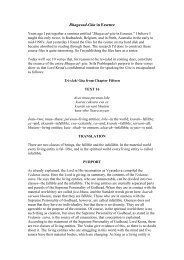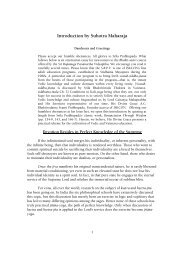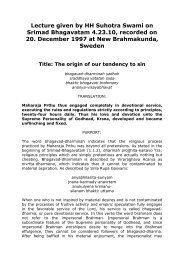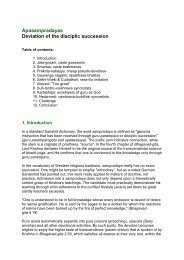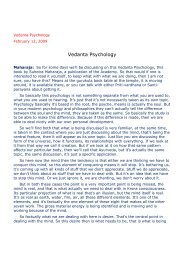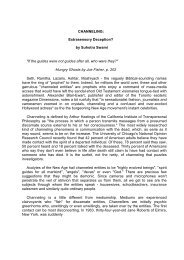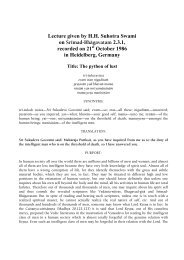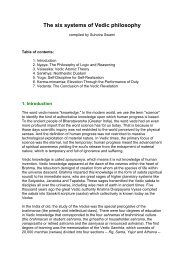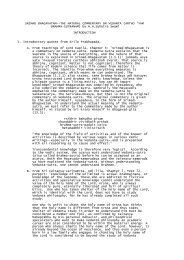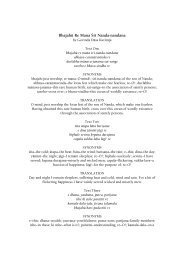All the different schools of Vedanta (advaita, suddhadvaita, vasistadvaita, dvaita,dvaitadvaita and acintya-bhedabheda-tattva) agree that the <strong>Upanisads</strong> cover fivetopics of instruction:1. <strong>The</strong> nature of Brahman2. <strong>The</strong> nature of the individual self and its relationship to Brahman3. <strong>The</strong> origin and development of the universe and its relationship to Brahman4. <strong>The</strong> means of attaining Brahman5. <strong>The</strong> nature of the supreme goal of life.So, starting with topic number 1 we may ask, "<strong>What</strong> is this word, Brahman?" <strong>The</strong>Sanskrit word brahma is neutral in gender; it does not mean Brahma, the four-facedrajoguna-avatara of creation whose name has a long second vowel and is masculinein gender. <strong>The</strong> literal meaning of brahma or Brahman can be found in its root, brih--"growth," "expansion," "evolution," and "development. " Brhanti brhmayati tasmaducyate para brahma, states Atharvasiras Upanisad: "<strong>What</strong> is called Brahman growsand causes to grow. " Thus Vedanta-sutra 1. 1. 2. defines Brahman as janmadyasya-yathah,that from which everything originates.Again, Brahman is a neutral apellation, like the English word "God. " Prasnopanisadsays the syllable aum is verily that Brahman:etad vai satyakama parama ca aparama ca brahma yad aumkarahtasmat vidvan etenaiva ayatanena ekataram anvetiThat which is the syllable aum, O Satyakama, is verily the parama and aparamaBrahman. <strong>The</strong>refore, he who meditates attains one or the other through this supportalone.Isopanisad addresses Brahman as Isa, the supreme controller of the universe.Mahanarayana Upanisad declares,narayana param brahma tattvam narayanah parahnarayanaa paro jyotir atma narayanah parahNarayana is the Supreme Brahman. Narayana is the Supreme Reality. Narayana isthe Supreme Light. Narayana is the Supreme Self.Other terms often found in the <strong>Upanisads</strong> for Brahman are atman, sat, aksara,prana, akasa, jyotis, purusa, isvara and paramesvara.<strong>The</strong> Nature of BrahmanVedantists consider the nature of Brahman in two categories: svarupa (essence) andsvarupa-nirupaka dharma (attributes). According to Taittiriya Upanisad, Brahman issatya (real), jnana (knowledge) and ananta (endless). <strong>The</strong> <strong>Upanisads</strong> themselvesapply these three to both the svarupa and svarupa-nirupaka dharma of Brahman;Mayavadi commentators reserve them only for svarupa, considering the attributes(which include the living entities and the material energy) to be unreal, ignorant andlimited, thus having no relationship to Brahman whatsoever.2
To illustrate how the <strong>Upanisads</strong> apply satyam jnanam anantam to both Brahman inessence and Brahman in attribute, Chandogya VIII. 3. 4 states tasya ha va etasyabrahmano nama satyamiti, that satyam is a name of Brahman. <strong>The</strong> next verseexplains that satyam is composed of 3 syllables: sat, ti and yam; the first means"immortal," the second means "mortal" and the third means "that which holds thetwo together" (yamayati). Thus Brahman is that which controls both the consciousliving entities and the non-conscious material energy, and brings them together toexhibit the universal creation. About the next feature of Brahman's nature, jnanam(knowledge), Aitreya Upanisad III. 1. 3 states prajnanam brahma, that Brahman isprajnana (great knowledge), and that living entities and non-sentient matter areprajnana pratisthitam, sustained by the prajna that is Brahman. Regarding theendlessness of Brahman (ananta), Isopanisad 5 states, tad antarasya sarvasya tad usarvasyasya bahyatah, that Brahman is within everything and at the same timeoutside of everything. Similarly, Katha Upanisad teaches that Brahman is at oncesmaller than the smallest and greater than the greatest.All this is consistent with the basic definition of Brahman as that which expands andcauses everything else to expand. If Brahman is essentially satyam jnanam anantam, thenthat which grows from Brahman must share in that nature to some degree. Brahman asthe source of expansion is not well-served by the Mayavadi theory that the cosmicmanifestation is of a different essence than Brahman, i. e. unreal, ignorant and limited.<strong>What</strong> the <strong>Upanisads</strong> <strong>Teach</strong>Part Two<strong>The</strong> Bliss of BrahmanYesterday we learned that Taittiriya Upanisad presents three characteristics thatdefine Brahman: satyam, jnanam and anantam. <strong>The</strong> same Upanisad expounds theVedantic doctrine of panca-kosa or five levels of Brahman realization. <strong>The</strong> fifth andultimate level is anandamaya (abundantly blissful). For an explanation of all five, onemay refer to Bhagavad-gita As it Is 13. 5p and Chapter 86 of Krsna, "Prayers by thePersonified Vedas. " About anandamaya, Taittirya II. 6. 1 states, so akamayatabahusyam prajayeyeti. . . idam sarvam asrjata, "this willed to become many. . . andcreated everything. " Remembering the definition of Brahman that was discussedyesterday, we must conclude that ananda is intrinsic to Brahman that expands andcauses everything else to expand.In the entry to this journal of 2nd November I related the teaching of theBrahmavalli portion of Taittirya Upanisad. Here too the conclusion is that Brahman isthe state of incomparable bliss, beyond even the happiness of Prajapati Brahma,what to speak of entities below him. Vedanta-sutra 1. 1. 12 makes reference toBrahmavalli in Vyasadeva's statement anandamayo abhyasat (V-s 1. 1. 12). SrilaPrabhupada discusses this sutra in his introduction to Bhagavad-gita As it Is and inhis purport to Bg 6. 20-23.For Gaudiya Vaisnavas, the message of Taittiriya II. 7. 1 is most pertinent: raso vaisah, "He is rasa. " <strong>The</strong> Upanisad explicates rasa thusly: esa hy eva anandayati, "thisverily bestows bliss. " If rasa bestows ananda, and rasa is Brahman, then Brahmanmust be of the nature of bliss.3



